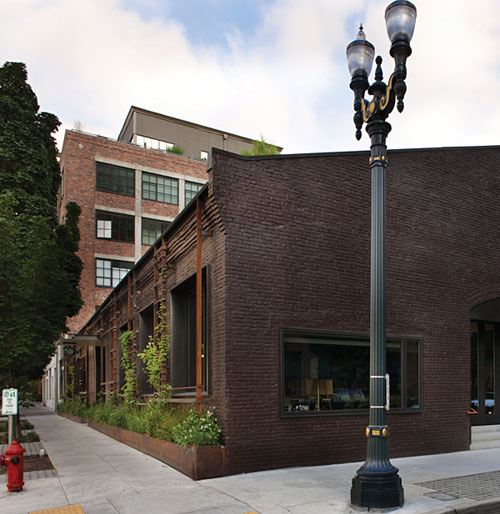Renovating an Historic Structure for LEED Platinum Certification
Natural and Artificial Lighting
Daylighting is an important step to leveraging natural light through the use of open-air design. During the design process, it was recommended to consider incorporating atriums, skylights, and windows to draw sunlight into workplaces and take advantage of this abundant natural resource. It's also important to balance artificial light with natural light to create a healthy and desired light balance in the building.
With an abundance of windows, doors and skylights in its new space, the Center for Architecture was able to earn two LEED points for Daylight and Views (EQ Credits 8.1 and 8.2).
The goals of these points are to provide a connection between indoor spaces and outdoor environments through the use of daylight and views in the occupied areas of the building.
"The existing structure did have quite a few windows and one existing skylight" said Scott. "Our lighting partner did a daylight analysis in terms of what was needed and made recommendations. We also held all of our design meetings in the space prior to the renovation with the lights turned off, so even on cloudy days our team knew there was good daylight."
For daylight points, LEED stipulates a building must achieve a minimum glazing factor of 2 percent in space occupied for critical visual tasks, not including copy rooms, storage areas, mechanical, laundry, and other low-occupancy support areas. Exceptions include those spaces where tasks would be hindered by daylight.
Glare control must be provided for all windows where direct sunlight would interfere with normal activities.
The Portland AIA building achieved a 2 percent glazing factor in over 75 percent of all spaces occupied for critical visual tasks.
 |
The Portland (Ore.) AIA chapter's Center for Architecture was the first AIA building in the world to earn a LEED platinum rating. Photo courtesy of Michael Mathers |
For views, spaces must achieve direct line of sight to the outdoor environment via vision glazing between 2'6" and 7'6" above the finished floor for building occupants in 90 percent (Credit 8.2) of all regularly occupied areas.
Given its bank of sliding doors that serve as windows, two skylights overhead and a six-panel folding door that provides near total outside views, the Center for Architecture earned a LEED point for sight lines that reached 90 percent of all regularly occupied areas.
"The space is small enough that with its open plan you can pretty much see outside from any spot in the building," noted Scott. "The design capitalized on the excellent resource that was provided to us."
The fenestration products were specifically designed and built to achieve both daylight and view points, and also accomplish the goal of opening up the one-story building to the sights and sounds of the neighborhood.
For the Portland AIA, day lighting has already proven to be an excellent strategy for increasing energy performance by eliminating the redundancy of artificial light when natural light is available. The Center utilizes low-energy light fixtures with daylight sensors to control energy usage and provide additional light as warranted by occupants. For the most part, the entire space relies on natural light throughout the day, a key contributor to reduced energy bills.
"One of the keys to success of our day lighting are the controls we selected," said Scott. "It is a low-voltage control system that allows for a lot of flexibility. We have daylight sensors that dim general lighting automatically when there is sufficient natural light. Occupancy sensors turn off lights if the space is vacated, and manual dimmers control shades and lighting levels when a darker room is needed."
Studies by the U.S. Green Building Council (USGBC) have shown that employee satisfaction improves when people are given control of their lighting environment. Shades or blinds can help them control natural light, and lighting controls can help control artificial light at workstations.
When it came to artificial lighting, the Portland AIA chapter has general illumination with a low Lighting Power Density (LPD) that supplements natural lighting during daylight hours. In work spaces this illumination is augmented with efficient task lighting providing point of use control to suit individual preferences.
Since its opening in 2008, the Portland AIA's Center for Architecture has been a welcome addition to the neighborhood, and identified as a model of sustainability by experts around the world. A look at its LEED scorecard shows the facility earned its Platinum rating by gathering 11 points for the sustainable site, five points for water efficiency, 13 points for energy and atmosphere, 12 points for materials and resources and five points for innovation and design.
The most recent addition to the structure, the USGBC's LEED Platinum plaque, hangs proudly in the front entry for all to see and serves as a constant reminder that this revitalized structure is a bright example for the future of sustainable architecture.
|









